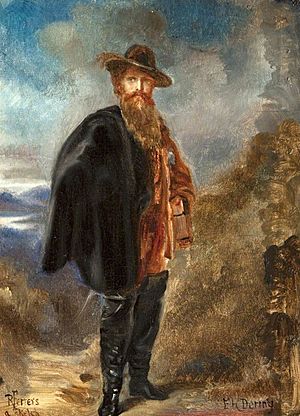Edward Heneage Dering facts for kids
Edward Heneage Dering (born 1826, died 1892) was an English writer from the Victorian era. He is mostly known for being part of a special group at Baddesley Clinton, a historic house. He also married two talented women who were artists.
Contents
Edward Dering's Life Story
Edward Dering was the younger son of Cholmeley Edward John Dering. His father was a church leader in Pluckley, Kent, and also at St Paul's Cathedral in London.
In 1844, Edward joined the army. He became an ensign in the 68th Foot regiment. By 1848, he was a lieutenant in the Coldstream Guards, another famous army unit. However, he caught malaria while in Italy. Because of his illness, he left the army in 1851.
Life at Baddesley Clinton
In 1859, Edward Dering married Lady Georgiana Chatterton, who was also a writer. Edward became a Catholic in 1865.
From 1869, Edward and Georgiana lived at Baddesley Clinton. This historic house was also home to Georgiana's niece, Rebecca Dulcibella Orpen, and her husband, Marmion Edward Ferrers. While living there, the Derings helped to improve the house. They also paid off some of the money owed on the property.
Lady Georgiana became a Catholic in 1875. Some people believe her husband's views on Catholicism influenced her decision. She passed away at Baddesley Clinton in 1876. Two years later, Edward Dering wrote a book about her life.
Edward continued to live at Baddesley Clinton. After Rebecca's husband died in 1884, Edward and Rebecca married in 1885. Edward helped with more improvements to the house. This included adding a new service area in 1890.
His Death and What He Left Behind
Edward Dering died at Baddesley Clinton in 1892. Many of his personal books, along with those of his wives, are still kept in the house today.
The collections at Baddesley Clinton also include several paintings of Edward Dering. These were painted by his second wife, Rebecca Dering. One painting, called "The philosopher's morning walk," shows him in his favorite old-fashioned clothes. He is standing in front of the moat at Baddesley Clinton.
Edward Dering's Books
Edward Dering wrote several novels. Some of his well-known books include:
- Lethelier (1860)
- A Great Sensation (1862)
- Grey's Court (1865)
- Florence Danby (1868)
- Sherborne: or, The House at the Four Ways (1875)
- Freville Chase (1880)
- The Lady of Raven's Combe (1891)
- The Ban of Mablethorpe (1894)
His books did not always get good reviews. He also wrote a book of poems called The Chieftains's Daughter (1870).
Edward Dering was also interested in a type of philosophy called neo-Thomist thought. He translated some works by a philosopher named Matteo Liberatore into English. He also wrote books that disagreed with a spiritual movement called theosophy. These included:
- Esoteric Buddhism (1887), which criticized the works of Alfred Percy Sinnett.
- The Philosopher of Rovereto (1888), which was a criticism of a book by Antonio Rosmini.


